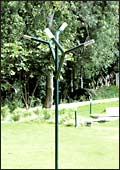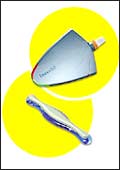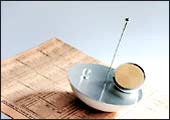 |
IDEATOR
Michael Foley
Head/Titan Design Studio |
Wren's London, Lutyen's Delhi, le
Corbusier's Brasilia (the city was based on his tenets but planned
not by him, but his followers), and, someday, Foley's Bangalore.
The first three were city-planners and architects; Foley is a
designer; but his spoor can be found all over Bangalore: in the
lights at Bal Bhavan, a children's play area in the city's Cubbon
Park (he has also designed benches and fences at the park), in
the signage of coffee bar chain Café Coffee Day, and in
Civet, a boutique restaurant (serves Thai) at the ITPL, a tech
park at White Field, on the outskirts of Bangalore. Foley's hand
will soon also be visible in a new hotel he is designing at Garuda
Mall, the city's retail-space-to-be-seen-in circa June 2005. That's
not quite the same as laying out a city but, hey, the man is only
34, and who is to say what he will and will not do in the years
ahead. Then, it seems only apt that the name of a young commercial
designer, in the prime of life, be associated with a young city,
an it-boomtown that is plagued by the pleasures and pains every
single boomtown that came before it has experienced.
Already in Bangalore, Foley is a mini-celebrity, especially
among A-listers as this most unscientific of sampling exercises
will prove.
Do you know Michael Foley? If so, what do you think of him and
his work?
| BIO-SKETCH |
MICHAEL
FOLEY
BORN: December 11,
1970
EDUCATION: 1988: High School
(Class XII), Kendriya Vidyalaya, Mhow
1993-94: NID
WORK: 1994: Trainee,Titan Industries
2000: Head, Titan Design Studio
INTO: Movies and playing pool
REALLY INTO: Nature and human
anatomy
ROLE MODEL: Ideo, Frog Design,
Phillipe Starck, Charles and Ray Eames
CAR: Steel grey Fiat Palio
BUSINESS SPEAK: Pushing the
envelope
OTHER SIDE: Outdoor sports freak;
plays basketball, swims regularly; has a pool table at home
for friendly contests with dad
AWARDS: 1998: Best bicycle design,
Taiwan R&D centre
LIFE'S AMBITION: Omnipresence
of products he has designed
WORST NIGHTMARE: Being rejected
completely and forgetting how to sketch overnight
MARITAL STATUS: Single |
Nandan Nilekani, CEO, Infosys Technologies, the city's best-known
technology firm knows of him and speaks of his role in developing
a custom-issue watch Infosys gifted employees when it crossed
the $1-billion-in-revenues (Rs 4,400-crore) mark. Incidentally,
Michael's role was supervisory; the watch was designed by his
younger brother Neil.
Captain G.R. Gopinath, CEO, Air Deccan, Dinesh Hinduja, Director,
Gokuldas Exports, and Geetanjali Kirloskar, Chairperson, India-Japan
Initiative have heard of Michael Foley too. All three believe
the Café Coffee Day design rocks with Gopinath saying that
"it stands out in the clutter of the city", and all
three believe that Titan's watches look good with Kirloskar saying
that "Michael has helped the company retain its design edge."
"I must say that Titan offers a wide range of well-designed
watches at reasonable prices," says Hinduja.
That's not bad going for someone who started off designing watches
as an apprentice at Titan Industries.
Mhow is a small Army town in Central India (it lies 23 km to
the south of Indore) that was founded in 1818 and has since enjoyed
the kind of public presence reserved for significantly larger
urban habitations. One reason for that could be the theory that
it is located at the geographical centre of India, with co-ordinates
of 22.34 N and 75.47 E (India extends from the eighth to the thirty-eighth
(north) latitude and the sixty-ninth to the ninety-seventh (east)
longitude, so this isn't true). Another is that the name Mhow
is derived from Military Headquarters of War or Military Headquarters
of Western India, both claims that ring hollow about a place that
has never been more than a divisional headquarters. Still, Mhow
(since renamed Dr Ambedkar Nagar, in honour of Dr B.R. Ambedkar
who was born there, although the old name has stuck) has had more
than its 15-minute share of the limelight. It has figured in the
writings of Rudyard Kipling, Winston Churchill spent some time
there as a sub-altern, India's only silver medallist in an individual
event at the Olympics, Major Rajyavardhan Rathore, was based there
at the time of his feat (2004, Athens), it is the most important
Army training centre in India, and, is, arguably, the first Wi-Fi
hot-spot in India. And, oh yes, the town's Kendriya Vidyalaya
School is where Michael Foley graduated from in 1988; Michael's
father Neville was in the Army and served across 11 centres.
 |
 |
| The fractal-inspired lighting at
Bangalore's Cubbon Park and Thai restaurant
Civet (in Bangalore, again), are two indications that
Michael Foley's spoor is becoming common in the city's topography |
Foley remembers those years fondly. "Being in small towns
has its advantages," he says. "You have a lot of time
on your hands and (since you are in an army town) there are almost
no boundaries." The man is probably referring to the thing
about Army towns being different, the last vestiges of the Raj,
really, bound by discipline and regimentation, though not the
same rules that bind other, 'civilian' towns, and places where
boys can be, well, boys. And so, young Michael sketched, painted
and modelled his way through childhood. Don't make the mistake
of writing him off as a pure right-brain type, though; while designing
the lights at Bal Bhavan he used the mathematical concept of fractals.
For the benefit of the uninitiated, a fractal is a complex geometric
object that can be divided into parts, each similar to the original
structure; a more fun way of looking at a fractal would be as
a vivid colourful geometric shape that lean more towards psychedelic
art than pure math.
It seemed only apt that young Foley go to the one place in India
where people endowed with similar skills go and have always gone,
the National Institute of Design (NID) in Ahmedabad. Since 1961,
when it was founded, the finishing school for designers (most
people are already that, in some form, when they enrol) has turned
out people who have influenced the shape and structure of India
in their own ways, big and small.
 |
| These digital doodads
that could have well featured in Minority Report were
designed by Foley for technology products hotshop Innoviti |
From T-shirts to furniture to stainless steel utensils (and cocktail
shakers) to newspapers and magazines to entire malls and fairgrounds,
NID alum have done it all, and done it well. And while Foley doesn't
go out and quite say it, the school may well have awakened the
industrial designer in him. After all, for someone who grew up
painting-his parents encouraged him to paint, and he would often
spend weekends copying the works of the Old Masters-it does seem
strange that Foley hasn't painted anything in the past decade
(he graduated from NID in 1994). However, that seems the right
thing to do for someone who sees himself as an industrial designer,
a person who has to focus on issues such as cost, utility and
customer-requirements, not an artist, an individual focussed on
self-expression. "Michael was very adept at understanding
design and getting into the finer details of a project,"
remembers Pradyumna Vyas, Principal Designer, NID, one of Foley's
instructors. "He possessed an admirable mix of design skills
and conceptualisation and was able to think out-of-the-box, yet
devise viable devices."
And it seemed only apt that Foley sign on with Titan Industries
as a trainee in the design department. Since the time it burst
on the scene to take on a moribund HMT in 1984, Titan has always
been a company that realises the importance of design; with its
recent foray into Fastrack sunglasses and accessories (earrings
and the like), it is evident that the company also realises the
benefits of leveraging its design-strength to diversify.
Titan Design Studio was created in 1998, when the company decided
to merge its visual merchandising and product design departments.
Foley took over as its head in 2000 and today, heads a team of
25, which includes his younger brother Neil. The Foleys appear
a design-oriented family; Neil's wife Pallavi Dudeja Foley is
a designer with Tanishq, Titan's branded-jewellery arm. And knowing
fully well that a single-minded focus on watches could have a
detrimental affect on the skills of its design team, Titan allows
employees of Titan Design Studio to undertake other projects as
long as these do not interfere with their work in any way.
 |
| Michael at home surrounded
by his designs, succesful and unsuccesful; the two
metal constructs in front are scale models of the fractal-inspired
lamp-posts he has designed |
The studio, Foley himself, and Titan, all shot into prominence
in 2002 with the launch of Edge, the company's range of the slimmest
commercially available (important, because there are slimmer prototypes
and the like) watches, each a mere 3.5 mm thin. Not just is Edge
revolutionary (in terms of thinness), watches in this range were
priced between Rs 4,495 and Rs 4,995 when they were launched,
one indication of Foley's ability to balance form, function and
price. That, say people who have worked with him, was always a
given. "Michael has a refined sense of form, function and
manufacturability, which means what can be made and the costs
involved," says Xerxes Desai, the former Chairman of Titan
and Foley's mentor. "I first met Michael when he was a precocious
trainee on the Titan design team and was instantly struck by his
brilliant ideas," adds Bijou Kurien, Chief Operating Officer,
Titan, adding that apart from being the country's best designer,
Foley brings expertise in ergonomics and usability.
That's evident in Foley's design projects that do not involve
Titan. Like Vaayu, a wireless internet connector, and Mita, a
wireless mobile phone extension device for city-based tech hotshop
Innoviti. "Mike can imagine user scenarios, then work out
a design," says Rajiv Agarwal, Founder and CEO, Innoviti.
"As a result, his products are simple in conception and because
of that, they appeal to customers."
Foley himself believes the scope for design in infinite. "There's
a huge potential in urban areas," he says. "Many highways,
for instance, have signboards that are functional rather than
well-designed." That sentiment about under-designed signboards
doesn't mean Foley is about to jump off the deep end and start
redesigning everything he can see. For one, he is not into over-designing
things. "Michael has got a minimalist streak in him,"
says Desai. "There is no unnecessary colour or design in
his work and he isn't a decorator or into ornamental stuff."
For another, Michael believes in simplicity. "You don't need
five different things to handle five different functions,"
he once told a magazine. "I try to minimise complexity."
At one level, that translates into a whole-new perspective of
design. Design, he insists, is not about creating stand-alone
silos for different product categories. Thus, Foley has tried
to incorporate design elements from the Fastrack range of sunglasses
into watches. The auto-companies call that approach platform sharing.
And car making remains the most complex of manufacturing processes.
 |
 |
 |
| More products from Michael's 'factory':
a really cool bicycle; a cooler radio
(it really is one) and a watch that is as much a reflection
of cutting edge-design as it is, his respect for his day-job
at Titan |
When the weather allows it-it doesn't between June and August-Foley
goes rowing every morning in Bangalore's Ulsoor lake. These days
he has to be content with a five-km walk in the evening, something
that he doesn't miss very often; work-timings, claims Foley, are
fairly regular, dispelling the image of ordered-chaos right-brain
types have always striven to acquire. Ideas, he says, can strike
him everywhere.
We are conversing in the study of his home in Bangalore's cantonment
area, and the evidence around indicates that the line between
work and life is very thin for this man. There's a whiteboard
in his study, with jottings of the kind that denote an active
mind, phone numbers, future concepts, ongoing projects; he is
surrounded by his designs (an article on the Tata website claims
he decorates his apartment with his failed designs). And despite
the fractals (remember, the lights), he smiles, he is not a quant-jock:
"... but I have a great fascination for scientific principles
and use them extensively at work." That shows, says Innoviti's
Agarwal. "Good design keeps in mind the entire usage of the
product, how and where it is bought, even how the user opens the
box...," he says, "and this was a capability we found
lacking in all designers until we met Mike."
 |
| Foley believes in balancing form, functionality
and cost; his mentor and Titan's former CEO calls him a
minimalist; this book-rack indicates that he is indeed
that |
It is that ability that Foley-he counts Andy Warhol, Jonathan
Ive of Apple Design Studio fame, industrial designer Phillipe
Starck and comic books among role models and sources of inspiration-will
increasingly have to leverage as he moves into more challenging
assignments, the kind of which lend credence to Foley's-Bangalore
kind of statements. "What I want to do is to take up projects
at the concept stage and provide an entire range of design services,"
says Foley. "This may not be possible on my own and I have
to work with others in the field to pool our skills." For
the Café Coffee Day project, for instance, Foley worked
with fashion designer Sandeep Khosla.
That's the now of it. The future, he hints, could well see him
dabbling in electronics, a white-hot market for industrial designers.
"Imagine designing a gaming device that can be used with
just one hand," he says, his eyes locked on to a mental diagram
of what the product will look like (close enough to touch for
him; immeasurably far for this reporter). "You can play even
when you are travelling (in the metro) or holding a bag."
What you hear, Mr Foley, is the sound of two hands clapping.
|












